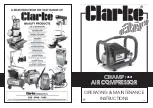
Electrical Connections
230 Volt models:
Connect the mains lead to a standard 230 Volt (50Hz) electrical supply through
an approved BS1363, 13amp plug or a suitably fused isolator switch.
110 Volt models:
Connect the mains lead to a suitable 110 Volt (50Hz) electrical supply through an
approved plug or a suitably fused isolator switch. If using a portable 110 Volt
transformer make sure it has a rated capacity sufficient to take the load of the
compressor (4.5kVA).
All models:
We recommend that the compressor is connected to the mains supply through a
Residual Current Device (RCD).
WARNING! THIS APPLIANCE MUST BE EARTHED
IMPORTANT: The wires in the mains lead are coloured in accordance with the
following code:
Green & Yellow
-
Earth
Blue
-
Neutral
Brown
-
Live
As the colours of the flexible cord of this appliance may not correspond with the
coloured markings identifying terminals in your plug proceed as follows:
•
Connect GREEN & YELLOW cord to terminal marked with a letter “E” or Earth
symbol “ ” or coloured GREEN or GREEN & YELLOW.
•
Connect BROWN cord to terminal marked with a letter ‘L’ or coloured RED
•
Connect BLUE cord to terminal marked with a letter ’N’ or coloured BLACK
230 Volt models:
If this appliance is fitted with a plug which is moulded onto the electric cable (i.e.
non- rewirable) please note:
1.
The plug must be thrown away if cut from the electric cable.There is a danger
of electric shock if it is subsequently inserted into a socket.
2.
Never use the plug without the fuse cover fitted.
3.
Should you wish to replace a detachable fuse carrier, ensure that the correct
replacement is used (as indicated by marking or colour code).
4.
Replacement fuse covers can be obtained from your local dealer or most
electrical stockists.
5.
The fuse in the plug must be replaced with one of the same rating (13amps)
and this replacement must be ASTA approved to BS1362.
If in doubt, consult a qualified electrician....DO NOT attempt repairs yourself
4
Fault Finding
9
Problem
Compressor stops and
will not restart.
Unable to adjust air
outlet pressure.
Air leaking from pressure
switch when the
compressor is not
running.
Compressor will not start
or stop automatically
Compressor runs
continuously, will not
reach pressure.
Compressor overheats.
Compressor noisy.
Probable cause
Compressor overloaded and thermal overload
protection has operated - remedy the cause of the
overload, then reset the overload trip (see figure 7).
Fuse blown - check and replace. If the fuse blows
repeatedly have the compressor checked.
Pressure regulator faulty - check and replace if
necessary.
Non-return valve leaking - disassemble non-return
valve, clean or replace if necessary.
Defective automatic pressure switch - have the
pressure switch checked and replaced if necessary.
Air filter blocked - clean filter.
Air leaks - check hoses and couplings.
Valves dirty or blocked - have compressor serviced.
Compressor may be too small for your application.
Air filter blocked - clean filter.
Insufficient ventilation - relocate compressor.
Low oil level - check oil.
Motor cooling fins dirty - clean compressor exterior.
Valves dirty or blocked - have compressor serviced.
Loose bolts - tighten.
Valve broken - have compressor serviced.
Bearings worn - have the bearings checked and
replaced if necessary.
WARNING!
Always disconnect the compressor from the electrical supply and






























